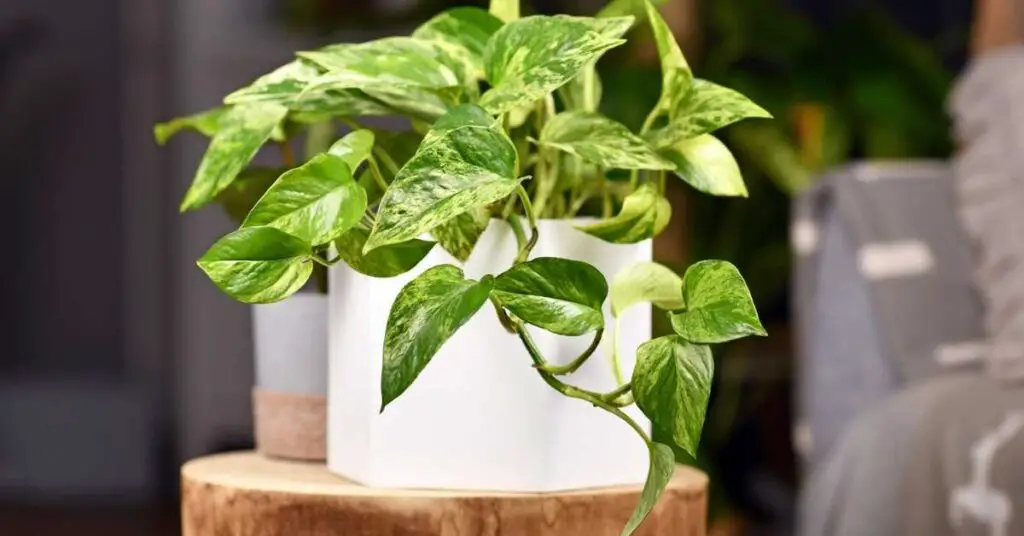Do Neon Pothos climb? Yes, neon pothos plants do indeed climb. These plants, a cultivar of the Epipremnum aureum species, exhibit a natural climbing behavior. When provided with a trellis, moss pole, or other forms of support, neon pothos will readily climb upward, creating an aesthetically pleasing and lush vertical display of its vibrant neon-green leaves. This climbing ability is a distinctive feature of the neon pothos, making it a popular choice for both hanging baskets and indoor decorative displays.
In this article, we will explore the factors that affect the climb of neon pothos and provide you with tips on training and supporting structures.
Get ready to encourage vertical growth and create a lush, thriving environment for your neon pothos!
Key Takeaways
- Neon pothos has a natural inclination to climb and can be trained to do so.
- Availability of support and proper lighting are essential for the plant’s successful climb.
- Trellises, moss poles, and frames are suitable support structures for neon pothos.
- Regular monitoring, pruning, and training are necessary to encourage desired growth direction.
Is Neon Pothos a Vine?
Yes, neon pothos (Epipremnum aureum ‘Neon’) is indeed a vine. It belongs to the same species as the more common golden pothos and exhibits a trailing or climbing growth habit. Its long, cascading stems and vibrant neon-green leaves make it a popular choice for indoor hanging baskets and decorative plant displays.
Understanding the Climbing Nature of Neon Pothos
The climbing nature of neon pothos isn’t only fascinating but also beneficial. One of the primary benefits of a climbing neon pothos is its ability to purify the air by absorbing harmful pollutants. This makes it an ideal plant for indoor spaces.
But what triggers its climbing behavior? The role of light is crucial in this process. Neon pothos uses phototropism, a biological response to light, to guide its growth towards a light source. It senses the direction of light and adjusts its growth accordingly, allowing it to climb and reach for more light.
Understanding this behavior helps us create suitable environments where neon pothos can thrive, contributing to a sense of belonging and well-being in our surroundings.

Factors Affecting the Climb of Neon Pothos
To ensure successful climbing, you should consider both the amount of available support and the intensity of light. These factors play a crucial role in the growth and climbing capabilities of Neon Pothos.
Firstly, the availability of support is essential for the plant to climb and spread. Neon Pothos has aerial roots that allow it to attach itself to various surfaces such as walls, poles, or trellises. Without sufficient support, the plant may struggle to climb and reach its full potential.
Secondly, the intensity of light is another critical factor affecting the climb of Neon Pothos. This species prefers bright, indirect light, and insufficient light can lead to weak and leggy growth.
Therefore, providing proper support and ensuring adequate light are vital aspects of caring for Neon Pothos and promoting its successful climb.
Can Neon Pothos Be Trained to Climb in a Specific Direction?
To encourage vertical growth in your neon pothos and train it to climb in a specific direction, use trellises or moss poles for support. These techniques will help your plant thrive and create a sense of belonging in your space.
How to Train Neon Pothos to Climb
Begin training your Neon Pothos to climb by gently guiding its tendrils towards a support structure. To ensure successful training, follow these techniques:
- Choose the best climbing support: Provide a sturdy structure that can withstand the weight of the plant as it grows. Options include trellises, moss poles, or frames.
- Position the support: Place the climbing support near the plant, allowing the tendrils to easily reach and attach themselves.
- Encourage attachment: Use soft ties or twist ties to secure the tendrils to the support. Avoid using materials that could damage the plant, such as wire or string.
- Monitor growth: Regularly check the plant’s progress and adjust the ties as needed to support new growth.
- Prune and train: Trim any long or unruly tendrils to encourage the plant to grow in the desired direction.
How Long Does It Take for Neon Pothos to Start Climbing?
Factors affecting the climbing speed of neon pothos include light, humidity, and availability of support. To encourage vertical growth, provide a moss pole or trellis for the plant to latch onto.
Can Neon Pothos Climb Without Any Support?
Yes, Neon Pothos can climb without any support. It is their natural climbing behavior. Factors like availability of light, humidity, and presence of aerial roots influence their climbing ability.
Supporting Structures for Neon Pothos Climb
Choose a sturdy support structure for your Neon Pothos to climb, such as a trellis, moss pole, or frame. These supporting structures provide stability and encourage vertical growth, allowing your Neon Pothos to flourish. Consider the following options when selecting the ideal support for your plant:
| Supporting Structures | Description |
|---|---|
| Trellis | A framework of interwoven or intersecting pieces of wood or metal that provides a climbing surface for the Neon Pothos. It can be attached to a wall or placed in a pot. |
| Moss Pole | A pole covered in moss that mimics the natural habitat of the plant, providing a climbing surface and moisture retention. It is ideal for promoting aerial root development. |
| Frame | A rigid structure made of wood or metal that can be customized to fit your space and aesthetic preferences. It offers support and allows the plant to climb and trail along its surface. |
With these supporting structures, you can train your Neon Pothos to climb in a controlled and aesthetically pleasing manner. Experiment with different training techniques, such as gently tying the vines to the support or guiding them towards it. Remember to regularly check the plant’s growth and adjust the support as needed. Providing the right support will not only enhance the beauty of your Neon Pothos but also promote healthy growth and a sense of belonging in your space.

Tips for Encouraging Vertical Growth in Neon Pothos
Encourage vertical growth in your Neon Pothos by providing proper support and regularly pruning any trailing vines.
Here are some tips to help you achieve this:
- Use a trellis or moss pole: These vertical supports will provide a structure for your Neon Pothos to climb and grow upwards.
- Train the vines: Gently guide the vines towards the support structure, encouraging them to wrap around and climb upwards.
- Provide ample light: Neon Pothos thrive in bright, indirect light. Place your plant near a window or provide artificial lighting to promote vertical growth.
- Water appropriately: Ensure that your plant is receiving adequate water, but avoid overwatering as this can lead to root rot and hinder growth.
- Fertilize regularly: Use a balanced, water-soluble fertilizer to provide essential nutrients for healthy growth.
Common Issues and Solutions for Neon Pothos Climbing
Avoid excessive trailing and ensure proper support for your Neon Pothos to prevent issues and promote healthy climbing.
While Neon Pothos are known for their natural climbing ability, there are some common issues that may arise during the climbing process. One issue is the lack of support, which can lead to the plant falling or bending unnaturally. To address this, use stakes or a trellis to provide support for your Neon Pothos as it climbs.
Another issue is the plant not attaching itself to the support structure. In this case, gently guide the vines towards the support and use plant ties or twine to secure them in place.
Additionally, if your Neon Pothos isn’t growing or climbing as expected, it may be due to insufficient light or improper watering. Ensure that your plant receives adequate light and water to encourage healthy growth and climbing.
Pruning Techniques to Control Neon Pothos Climb
To control the climb of your Neon Pothos, you should regularly prune the vines. Pruning benefits include keeping the plant manageable and preventing it from overtaking its surroundings.
Here are some pruning techniques to help you control the climb of your Neon Pothos:
- Pinching: Use your fingers or pruning shears to pinch off the tips of the vines. This encourages branching and prevents the plant from growing too long.
- Cutting: Trim back any excessively long or wayward vines to maintain the desired shape and size of the plant.
- Thinning: Remove some of the older vines to promote new growth and prevent overcrowding.
- Training: Direct the growth of the vines by gently guiding them along a trellis or support structure.
- Root pruning: If your Neon Pothos becomes too large, you can prune the roots by repotting the plant in a smaller container.
Alternatives to Climbing for Neon Pothos
If climbing is not desirable for your Neon Pothos, consider using alternative methods to control its growth. While Neon Pothos are known for their ability to climb and vine, they can also thrive in a non-climbing environment with proper care.
To provide the best conditions for your Neon Pothos, pay attention to its potting requirements. Choose a well-draining potting mix that retains some moisture but does not become waterlogged. Additionally, ensure that the pot has drainage holes to prevent waterlogging.
When it comes to propagation methods, Neon Pothos can be easily propagated through stem cuttings. Simply select a healthy stem, make a clean cut just below a node, and place the cutting in water or a well-draining potting mix.
With these alternative methods, you can still enjoy the beauty of your Neon Pothos without the need for climbing support.
| Potting Requirements | Propagation Methods |
|---|---|
| Well-draining mix | Stem cuttings |
| Moist but not waterlogged | Place in water or potting mix |
Frequently Asked Questions
Can Neon Pothos Climb on Horizontal Surfaces?
Yes, Neon Pothos can climb on horizontal surfaces. In their natural habitat, they tend to grow vertically, but with the right support, such as a trellis or moss pole, they can also climb horizontally.
Is It Necessary to Trim the Leaves of Neon Pothos for Better Climbing?
To improve climbing, it is necessary to trim the leaves of Neon Pothos. Pruning benefits include increased growth and better support for the plant. Pruning techniques involve cutting back long vines and removing damaged or yellowing leaves.
How Do You Make Neon Pothos Bushy?
To encourage a bushier growth pattern in neon pothos, you can regularly pinch or prune the tips of the stems. This practice stimulates branching and results in a denser, fuller plant. Additionally, providing the plant with appropriate lighting conditions and regular fertilization can also promote bushier growth.
Where Do You Put Neon Pothos?
Neon pothos thrives in bright, indirect light but can tolerate lower light conditions. It’s an excellent choice for offices, living rooms, bathrooms, or any indoor space with filtered sunlight. Avoid placing it in direct sunlight, as this can scorch the leaves. Ensure that the pot has proper drainage to prevent overwatering.
Do Pothos Get Bigger if They Climb?
Pothos plants can grow larger when they climb or trail. Allowing the vines to climb up a support structure or providing them with adequate room to trail and grow can result in a more expansive and impressive plant. The size of a pothos ultimately depends on factors like care, space, and environmental conditions.
How Big Do Neon Pothos Get?
Neon pothos can reach varying sizes, but they typically grow to be around 6 to 10 feet (1.8 to 3 meters) in length when they are given room to climb or trail. However, the ultimate size of your neon pothos will depend on factors such as light, humidity, and care practices.
Are Neon Pothos Rare?
Neon pothos is not considered a rare plant. While its vibrant neon-green leaves make it distinctive and highly sought after, it is a cultivar of the more common golden pothos (Epipremnum aureum) and is readily available at many plant nurseries and garden centers. Its popularity has made it a relatively common houseplant choice among enthusiasts.
Conclusion
In conclusion, neon pothos is a climbing plant that requires proper training and support structures to encourage vertical growth. Factors such as light, humidity, and temperature can affect its climbing ability.
By using techniques such as pruning and providing alternative support methods, gardeners can control the climb of neon pothos and ensure its healthy growth. Understanding the nature of this plant and implementing the appropriate measures will lead to a thriving and beautiful climbing neon pothos.



